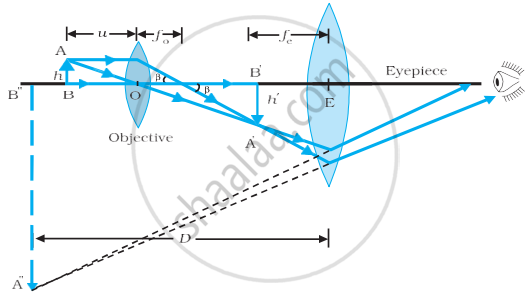Advertisements
Advertisements
प्रश्न
Draw a ray diagram of compound microscope for the final image formed at least distance of distinct vision?
उत्तर
Diagram of Compound Microscope for the final image formed at D:
APPEARS IN
संबंधित प्रश्न
Why must both the objective and the eyepiece of a compound microscope have short focal lengths?
Suggest two ways by which the resolving power of a microscope can be increased?
A compound microscope has an objective of focal length 1.25 cm and eyepiece of focal length 5 cm. A small object is kept at 2.5 cm from the objective. If the final image formed is at infinity, find the distance between the objective and the eyepiece ?
A man is looking at a small object placed at his near point. Without altering the position of his eye or the object, he puts a simple microscope of magnifying power 5 X before his eyes. The angular magnification achieved is
A compound microscope forms an inverted image of an object. In which of the following cases it it likely to create difficulties?
Draw a neat labelled ray diagram showing the formation of an image at the least distance of distinct vision D by a simple microscope. When the final image is at D, derive an expression for its magnifying power at D.
Define the magnifying power of a microscope in terms of visual angle.
With the help of a ray diagram, show how a compound microscope forms a magnified image of a tiny object, at least distance of distinct vision. Hence derive an expression for the magnification produced by it.
| A compound microscope consists of two converging lenses. One of them, of smaller aperture and smaller focal length, is called objective and the other of slightly larger aperture and slightly larger focal length is called eye-piece. Both lenses are fitted in a tube with an arrangement to vary the distance between them. A tiny object is placed in front of the objective at a distance slightly greater than its focal length. The objective produces the image of the object which acts as an object for the eye-piece. The eye-piece, in turn, produces the final magnified image. |
A compound microscope consists of an objective of 10X and an eye-piece of 20X. The magnification due to the microscope would be:
In a compound microscope an object is placed at a distance of 1.5 cm from the objective of focal length 1.25 cm. If the eye-piece has a focal length of 5 cm and the final image is formed at the near point, find the magnifying power of the microscope.
